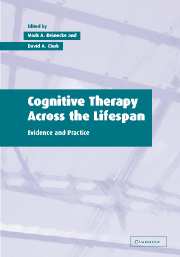Book contents
- Frontmatter
- Contents
- List of contributors
- Foreword
- 1 Cognitive therapy across the lifespan: conceptual horizons
- 2 Cognitive theory and therapy of depression
- 3 Cognitive theory and therapy of bipolar disorders
- 4 Regulation of emotion in generalized anxiety disorder
- 5 Cognitive theory and therapy of obsessions and compulsions
- 6 The cognitive model of panic
- 7 Treating obsessional problems using cognitive-behavioral therapy
- 8 Narcissistic personality disorder
- 9 Cognitive therapy and the self
- 10 Promoting cognitive change in posttraumatic stress disorder
- 11 Cognitive theory and therapy of social phobia
- 12 The cognitive model of bulimia nervosa
- 13 Cognitive therapy and schizophrenia
- 14 Cognitive-behavioral interventions for alcohol abuse and dependence
- 15 Cognitive approaches to understanding, preventing and treating child and adolescent depression
- 16 Cognitive-behavioral interventions in childhood anxiety disorders
- 17 Attention deficit/hyperactivity disorder
- 18 Cognitive-behavioral interventions for children with conduct problems
- 19 Processes of change in cognitive therapy
- 20 Cognitive therapy in the twenty-first century: current status and future directions
- Index
4 - Regulation of emotion in generalized anxiety disorder
Published online by Cambridge University Press: 05 July 2014
- Frontmatter
- Contents
- List of contributors
- Foreword
- 1 Cognitive therapy across the lifespan: conceptual horizons
- 2 Cognitive theory and therapy of depression
- 3 Cognitive theory and therapy of bipolar disorders
- 4 Regulation of emotion in generalized anxiety disorder
- 5 Cognitive theory and therapy of obsessions and compulsions
- 6 The cognitive model of panic
- 7 Treating obsessional problems using cognitive-behavioral therapy
- 8 Narcissistic personality disorder
- 9 Cognitive therapy and the self
- 10 Promoting cognitive change in posttraumatic stress disorder
- 11 Cognitive theory and therapy of social phobia
- 12 The cognitive model of bulimia nervosa
- 13 Cognitive therapy and schizophrenia
- 14 Cognitive-behavioral interventions for alcohol abuse and dependence
- 15 Cognitive approaches to understanding, preventing and treating child and adolescent depression
- 16 Cognitive-behavioral interventions in childhood anxiety disorders
- 17 Attention deficit/hyperactivity disorder
- 18 Cognitive-behavioral interventions for children with conduct problems
- 19 Processes of change in cognitive therapy
- 20 Cognitive therapy in the twenty-first century: current status and future directions
- Index
Summary
Introduction
Interest in the study of anxiety disorders has increased dramatically since the publication of the third edition of the Diagnostic and Statistical Manual of Mental Disorders (DSM-III; American Psychological Association (APA), 1980). In fact, the 1980s witnessed a 10-fold increase in the number of published articles devoted to the study of anxiety disorders (Norton et al., 1995), and anxiety disorders were the topic of 14% of the articles published in clinical psychology and psychiatry journals between 1990 and 1992 (Cox et al., 1995). The large majority of these studies focused on panic disorder (McNally, 1994) and social phobia (Heimberg et al., 1995). However, investigations of generalized anxiety disorder (GAD) have recently begun to appear with increasing frequency (Borkovec et al., 1991; Brownand Barlow, 1992; Wittchen et al., 1994).
Compared to other anxiety disorders, GAD remains poorly understood. Advances in understanding have been slowed by the evolving definition of the disorder. In DSM-III, GAD was a residual category that could not be diagnosed in the presence of any other anxiety or affective disorder (APA, 1980). Attempts to diagnose GAD according to DSM-III criteria were also characterized by low inter-rater reliability (Barlow, 1987). However, the diagnostic criteria for GAD changed substantially from DSM-III to DSM-IV (APA, 1994). GAD is no longer considered to be a residual category, but a disorder specifically characterized by excessive and uncontrollable worry and somatic symptoms suggestive of central nervous system hyperarousal (e.g., muscle tension).
- Type
- Chapter
- Information
- Cognitive Therapy across the LifespanEvidence and Practice, pp. 60 - 89Publisher: Cambridge University PressPrint publication year: 2003
- 5
- Cited by



